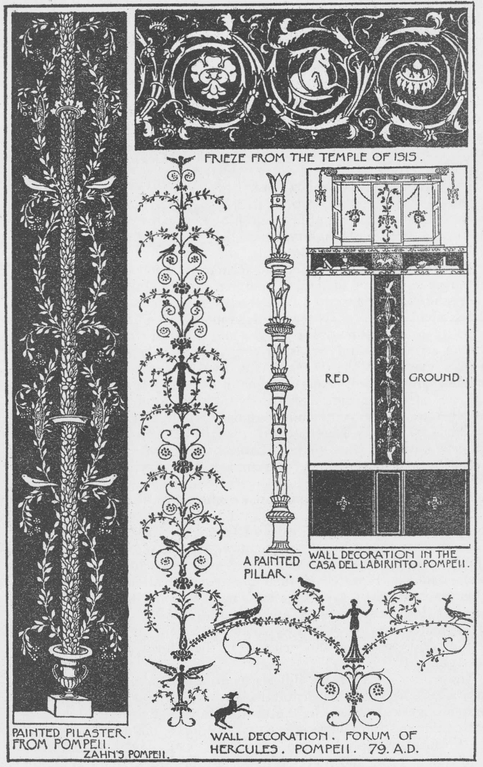Plate 13

POMPEIAN ORNAMENT
Pompeii, Herculaneum and Stabia, Roman cities, were buried by an eruption of Vesuvius, A.D. 79. These cities had already suffered from an earthquake, A.D. 63, and were being rapidly rebuilt when they were finally destroyed by the eruption. The Younger Pliny, the historian, was a spectator of the event at Pompeii, and wrote two letters to his friend Tacitus, describing the event and his flight from the doomed city, which remained buried for seventeen centuries, with the treasures of gold and silver, bronzes of rare workmanship, mural paintings on a most magnificent scale, and floors of mosaics of marvellous execution and design ; everything affording a vivid glimpse of the domestic and public life of the Romans of the 1st century A.D. Herculaneum was discovered in 1709, and Pompeii 1748, and from these cities many valuable remains of art have been taken. In the museum at Naples there are over 1,000 mural paintings, some 13,000 small bronzes, over 150 large bronzes of figures and busts, and 70 fine large mosaics.
A plan of a Roman house is given on page 25 showing the arrangement and use of the rooms. The floors were covered with mosaics (see plate 54), those of the vestibule, corridors and small rooms having simple patterns enclosed with borders of the key pattern, or the guilloche in black, red, grey and white tesseræ. The floor of the triclinium, or dining-room, was often a magnificent mosaic representing some mythological or classical subject. The walls were painted in colour, usually with a dado one-sixth the height of the wall, with pilasters dividing the wall into rectangular panels and a frieze above (plate 13). The general scheme of colour was, the dado and pilasters black, the panels red, and the frieze white ; or black dado, red pilasters and frieze, with white or yellow panels. The decoration upon these various coloured grounds was light and fanciful, and painted with great delicacy. Representations of architectural forms, such as columns and entablatures, are often rendered in perspective upon the painted walls.
The painted ornament has somewhat the same characteristics as the Roman relief work, but is usually much more delicate in treatment. The spiral form and the sheath are always prevalent, and from these sheaths and cups grow the finer tendrils or delicately painted spray of foliage, upon which birds are placed.
Stucco enrichments, such as ornamental string courses and mouldings, were frequently combined with the painted ornament ; they consist of small details, such as the water leaf, the egg and dart, and the anthemion, and are repeated in a regular series.
Herculaneum differed considerably from Pompeii, for here the finest works of art and innumerable MSS. have been found, showing that a higher intellectual life existed than that at Pompeii, where not a single MS. has been found.